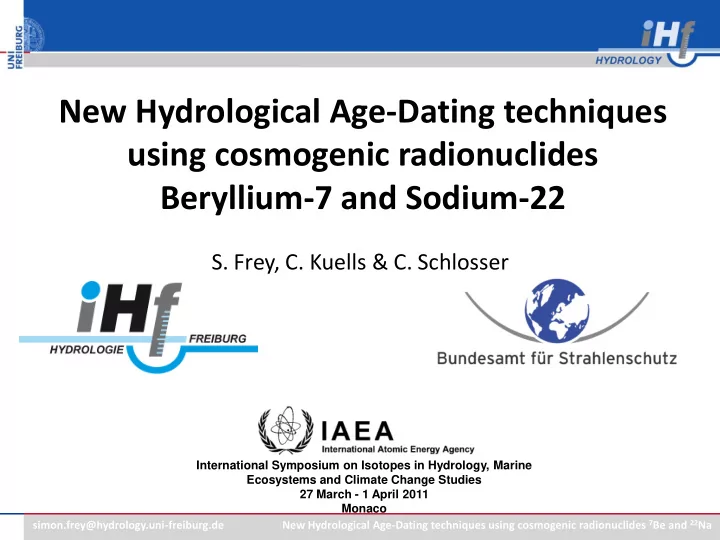

New Hydrological Age-Dating techniques using cosmogenic radionuclides Beryllium-7 and Sodium-22 S. Frey, C. Kuells & C. Schlosser International Symposium on Isotopes in Hydrology, Marine Ecosystems and Climate Change Studies 27 March - 1 April 2011 Monaco simon.frey@hydrology.uni-freiburg.de New Hydrological Age-Dating techniques using cosmogenic radionuclides 7 Be and 22 Na
Why new age-dating methods? • Tritium levels close to natural background • ³H/³He, 85 Kr, SF 6 , CFC etc. only if no contact to atmosphere [Happell et al. (2004), Tellus B] simon.frey@hydrology.uni-freiburg.de New Hydrological Age-Dating techniques using cosmogenic radionuclides 7 Be and 22 Na
Radionuclide Production • Produced by spallation processes in upper atmosphere • 7 Be about four times higher than 22 Na Surfaces of a constant 7 Be production rate (nuclei min -1 m -3 , at standard temperature and pressure). [Lal & Peters (1967), Handbuch der Physik] simon.frey@hydrology.uni-freiburg.de New Hydrological Age-Dating techniques using cosmogenic radionuclides 7 Be and 22 Na
Sorption of Sodium [Bjerg & Christensen 1993, j contam hydrol] [Birkholz 2007, unpublished] simon.frey@hydrology.uni-freiburg.de New Hydrological Age-Dating techniques using cosmogenic radionuclides 7 Be and 22 Na
Sorption of Beryllium • About 3 – 10 % of beryllium input is not affected by sorption • Recovery indicates mobilization mechanism [Data from Hohwieler 2005, unpublished] simon.frey@hydrology.uni-freiburg.de New Hydrological Age-Dating techniques using cosmogenic radionuclides 7 Be and 22 Na
Sampling simon.frey@hydrology.uni-freiburg.de New Hydrological Age-Dating techniques using cosmogenic radionuclides 7 Be and 22 Na
Chemical Separation 1. Eluting the resin Evaporating to dryness weighting 2. 3. Dissolving in 0.1M HCl Adjusting pH to 8 – 9 (NH 4 OH) 4. 5. Adding (NH 4 ) 2 CO 3 + EtOH 6. Centrifuging Evaporating to dryness (500 ° C) 7. 8. Dissolving in 0.1M HCl 9. Adding NaTPhB (Sodium-Tetra-Phenyl-Borate) 10. Filtering and washing 11. Evaporate to dryness g -Spectroscopy [Sakaguchi et al. 2003, J. Radioanal. Nucl. Chem. ] simon.frey@hydrology.uni-freiburg.de New Hydrological Age-Dating techniques using cosmogenic radionuclides 7 Be and 22 Na
Why separating potassium? 40 K Compton scattering masks exact measurements of the 1275 MeV-peak of 22 Na simon.frey@hydrology.uni-freiburg.de New Hydrological Age-Dating techniques using cosmogenic radionuclides 7 Be and 22 Na
Case Study in the Black Forest Dreisam Catchment • Area: ~ 258 km² • Precipitation: ~ 1500 mm/a • Evaporation: ~ 600 mm/a • Discharge: ~ 820 mm/a • Groundwater Discharge: ~ 60 mm/a Sampling locations • Two Groundwater wells (334 m & 1284 m a.s.l.) • Two Rivers (316 m & 434 m a.s.l.) • One Precipitation Station (melted snow, 277 m a.s.l.) simon.frey@hydrology.uni-freiburg.de New Hydrological Age-Dating techniques using cosmogenic radionuclides 7 Be and 22 Na
Results Activities and resulting ages of Sodium-22 measurements age [d] related to Error activity Data Sample Date [%] [mBq/l] Literature* obtained Schauinsland 12/01/09 NA < 0.04 > 2763 > 37 Brugga 12/14/09 NA < 0.03 > 3066 > 340 Hungerbrunnen 01/14/10 NA < 0.04 > 2847 > 121 Snow 01/21/10 19.3 0.04 2726 0 Dreisam 02/04/10 NA < 0.07 > 1974 0 Activities and resulting ages of Beryllium-7 measurements age [d] related to Error activity Data Sample Date [%] [mBq/l] Literature** obtained Schauinsland 12/01/09 NA < 0.12 > 555 > 518 Brugga 12/14/09 7.2 1.66 360 323 Hungerbrunnen 01/14/10 24.4 0.22 512 475 Snow 01/21/10 5.9 122.80 209 0 Dreisam 02/04/10 6.0 13.64 201 165 * 0.1 – 0.3 mBq/l (Tokuyama & Igarashi (1998), J. Environ. Radioactivity) ** 1 – 2 Bq/l (Knies et al. (1994), Nucl. Instr. and Meth. in Phys.) simon.frey@hydrology.uni-freiburg.de New Hydrological Age-Dating techniques using cosmogenic radionuclides 7 Be and 22 Na
Summary • Sodium-22 only detected in snow Possible explanation: Exchange resin, chemical separation, detector (HPGe 30% Efficiency), Sodium-Sodium-Exchange • Beryllium-7 in all samples but ‘ Schauinsland ‘ Possible explanation: Age, sorption processes • Dated ages match previously observed ages (Uhlenbrook et al. (2002), WRR): • Shallow groundwater: 2 – 3 years • Deep groundwater: younger than 10 years simon.frey@hydrology.uni-freiburg.de New Hydrological Age-Dating techniques using cosmogenic radionuclides 7 Be and 22 Na
Discussion Advantages Disadvantages 22 Na provides an alternative to Tritium, Long time for chemical analysis if combined with 7 Be even younger waters detecable Detection limit (esp. 22 Na) No gaseous tracers Large water samples needed (but small compared to 85 Kr) Thank you for your attention simon.frey@hydrology.uni-freiburg.de New Hydrological Age-Dating techniques using cosmogenic radionuclides 7 Be and 22 Na
Literature Bjerg & Christensen 1993: A field experiment on cation exchange-affected multicomponent solute transport in a sandy aquifer. J Contamt Hydrol 12, pp. 269-290. Happell et al. 2004 : A history of atmospheric tritium gas (HT) 1950 – 2002, Tellus B 53, pp. 183 – 193. Lal & Peters, 1967: Cosmic ray produced radioactivity on the Earth. Handbuch der Physik , pp. 551 – 612. Knies et al. 2004: 7 Be, 10 Be and 36 Cl in precipitation. Nucl. Instr. and Meth. in Phys. B 92, pp. 340 - 344. Sakaguchi et al. 2003: Low-level measurement of the cosmogenic 22 Na radionuclide in fresh water by ultra low-background gamma-ray spectrometry after simple radiochemical separation J. Radioanal. Nucl. Chem 258, pp. 101-105. Tokuyama & Igarashi 1998: Seasonal variation in the environmental background level of cosmic-ray- produced 22 Na at Fukui City, Japan. J. Environ. Radioactivity 38, pp. 147 - 161. Uhlenbrook et al. 2002: Hydrograph separations in a mesoscale mountainous basin at event and seasonal timescales. WRR 38, pp. 1-14. simon.frey@hydrology.uni-freiburg.de New Hydrological Age-Dating techniques using cosmogenic radionuclides 7 Be and 22 Na
Recommend
More recommend